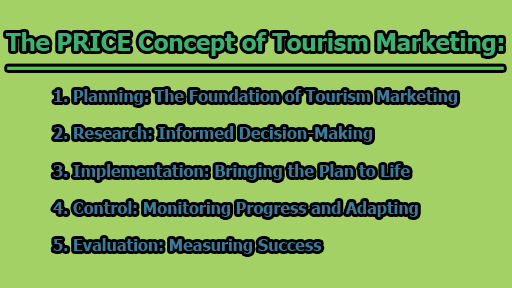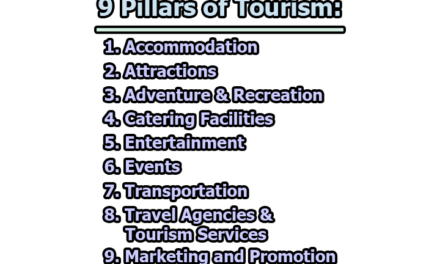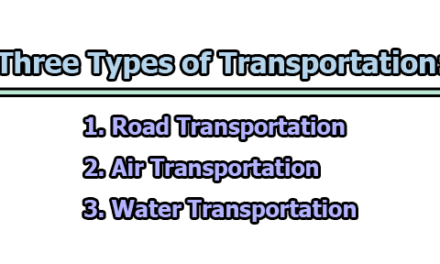The PRICE Concept of Tourism Marketing:
Tourism is a vital sector of the global economy, contributing significantly to GDP, job creation, and cultural exchange. In this highly competitive industry, effective marketing is essential for destinations to attract tourists, generate revenue, and sustain growth. The PRICE concept is a valuable framework that helps tourism marketers plan, research, implement, control, and evaluate their marketing strategies. In this article, we will delve into the PRICE concept of tourism marketing.
1. Planning: The Foundation of Tourism Marketing
1.1 Setting Clear Objectives: The planning phase of the PRICE concept begins with setting clear and measurable objectives. In tourism marketing, this could involve defining targets for increasing tourist arrivals, extending visitor stays, or boosting revenue from tourism-related activities. Objectives should be specific, realistic, and time-bound, providing a clear direction for marketing efforts.
1.2 Defining the Target Audience: Understanding the target audience is paramount in tourism marketing. Destinations must identify the demographics, psychographics, and behaviors of their potential tourists. Are they adventure seekers, cultural enthusiasts, or luxury travelers? By segmenting the audience, marketers can tailor their strategies to resonate with specific groups effectively.
1.3 Conducting Market Research: Comprehensive market research is the cornerstone of successful tourism marketing. It involves gathering data on market trends, competitor analysis, and consumer preferences. Marketers need to be aware of emerging trends in the travel industry, the competitive landscape, and the factors that influence tourists’ decision-making processes.
1.4 Developing a Marketing Strategy: Based on the insights gained from research, marketers can formulate a robust marketing strategy. This strategy should outline the marketing mix, including product offerings, pricing strategies, distribution channels, and promotional tactics. For instance, a destination known for its natural beauty might focus on eco-friendly tourism and promote its pristine landscapes.
1.5 Budget Allocation: Planning also involves budget allocation. Marketers need to determine how much financial resources are available for implementing the marketing plan. This allocation should align with the chosen strategies and objectives. Tourism destinations often allocate budgets for advertising, public relations, digital marketing, and infrastructure development.
2. Research: Informed Decision-Making
2.1 Market Intelligence: Once the plan is in place, the research phase of the PRICE concept begins. In tourism marketing, market intelligence involves continuously monitoring industry trends, tourist preferences, and competitive activities. Staying informed is essential to adapt to changing market conditions.
2.2 Competitor Analysis: Understanding the competition is critical in the tourism sector. Destination marketers must analyze the strengths and weaknesses of rival destinations, identify gaps in the market, and look for opportunities to differentiate themselves. This could involve benchmarking against similar destinations and assessing their marketing strategies.
2.3 Consumer Insights: Consumer insights provide valuable information about tourists’ needs, desires, and decision-making processes. This data can be collected through surveys, online reviews, and social media monitoring. For example, if tourists frequently mention a lack of affordable accommodation options, this insight can inform marketing efforts to address this issue.
2.4 Technology Trends: Technology plays a significant role in modern tourism marketing. Marketers must stay updated on technological advancements, such as mobile apps, augmented reality, and virtual reality experiences. Incorporating these technologies into marketing campaigns can enhance the visitor experience and set a destination apart.
2.5 Data Analytics: Data analytics is a powerful tool in tourism marketing. By analyzing data from website traffic, booking systems, and customer interactions, marketers can gain valuable insights into visitor behavior. This information can be used to optimize marketing campaigns, personalize offers, and improve overall customer satisfaction.
3. Implementation: Bringing the Plan to Life
3.1 Advertising Campaigns: Implementing the marketing plan involves launching advertising campaigns. These campaigns should align with the destination’s branding and messaging. For instance, if a destination is positioning itself as a family-friendly location, advertising materials should highlight family-oriented activities and amenities.
3.2 Content Creation: High-quality content is essential in tourism marketing. Destinations can create compelling content through blogs, videos, and social media posts that showcase the destination’s unique attractions and experiences. Content should be engaging, informative, and shareable to reach a wider audience.
3.3 Collaborations and Partnerships: Collaborations with airlines, hotels, travel agencies, and local businesses can amplify the marketing efforts of a destination. Partnerships can lead to joint marketing campaigns, package deals, and cross-promotion, attracting more tourists and increasing revenue.
3.4 Online Presence: In today’s digital age, a strong online presence is imperative. This includes an appealing and user-friendly website, active social media profiles, and online booking systems. Destinations must ensure that their online platforms provide accurate information, high-resolution images, and easy booking processes.
3.5 Visitor Services: The visitor experience is a crucial aspect of tourism marketing. Destinations must provide exceptional visitor services, including information centers, transportation options, and guided tours. Positive experiences can lead to word-of-mouth recommendations and repeat visits.
4. Control: Monitoring Progress and Adapting
4.1 Key Performance Indicators (KPIs): The control phase involves monitoring key performance indicators (KPIs) to assess the effectiveness of marketing efforts. KPIs may include tourist arrivals, website traffic, conversion rates, and revenue generated. These metrics help marketers track progress toward their objectives.
4.2 Data Tracking and Analysis: Data tracking and analysis are ongoing processes in tourism marketing. Marketers should regularly review data from various sources to identify trends and areas that need improvement. For example, if website traffic is high but conversion rates are low, marketers can investigate potential issues with the booking process.
4.3 Feedback Mechanisms: Feedback from tourists is invaluable. Destinations should have mechanisms in place to collect feedback through surveys, online reviews, and direct interactions. This feedback can highlight areas of improvement and inform marketing strategies.
4.4 Performance Adjustments: Based on the data and feedback gathered, marketers should be prepared to make adjustments to their marketing strategies. This might involve reallocating the budget to more effective channels, refining targeting strategies, or adapting messaging to address emerging trends or challenges.
4.5 Crisis Management: Tourism destinations may face unexpected crises, such as natural disasters, political instability, or health emergencies (as seen during the COVID-19 pandemic). Marketers must be prepared to respond promptly, provide accurate information, and adapt marketing strategies to mitigate the impact of crises on tourism.
5. Evaluation: Measuring Success
5.1 Assessing Marketing Objectives: In the evaluation phase, tourism marketers assess whether their objectives have been met. This involves comparing the actual outcomes to the initially set objectives. For example, if the objective was to increase tourist arrivals by 10%, marketers would evaluate whether this goal was achieved.
5.2 Return on Investment (ROI): ROI analysis is essential to determine the efficiency of marketing expenditures. Marketers should calculate the revenue generated from tourism marketing efforts and compare it to the costs incurred. A positive ROI indicates that marketing efforts are profitable.
5.3 Customer Satisfaction: Tourism destinations should continuously gauge customer satisfaction levels. This can be done through surveys, reviews, and direct feedback. High levels of customer satisfaction are indicative of effective marketing and positive visitor experiences.
5.4 Learning from Successes and Failures: The evaluation phase is also a time for learning. Marketers should analyze what worked well and what didn’t in their marketing campaigns. Successful strategies can be replicated, while unsuccessful ones can be revised or abandoned.
5.5 Adaptation and Future Planning: Based on the evaluation results, destinations should adapt their marketing strategies for the future. This might involve setting new objectives, adjusting budgets, and incorporating lessons learned into the next marketing cycle.
In conclusion, the PRICE concept of marketing, with its emphasis on Planning, Research, Implementation, Control, and Evaluation, provides a comprehensive and systematic approach to tourism marketing. In an industry characterized by fierce competition, rapidly changing consumer preferences, and external factors like global events and crises, this framework offers a structured way for destinations and businesses to navigate the complexities of marketing.
By diligently following the PRICE concept, tourism marketers can make informed decisions, optimize their strategies, and ultimately achieve their marketing objectives. Whether it’s attracting more tourists, increasing revenue, or enhancing the visitor experience, the PRICE concept serves as a guiding compass for success in the dynamic world of tourism marketing. As the tourism industry continues to evolve, the PRICE concept remains a valuable tool for those seeking to thrive in this vital sector of the global economy.
References:
- Buhalis, D., & Foerste, M. (2015). SoCoMo Marketing for Travel and Tourism: Empowering Co-Creation of Value. Journal of Destination Marketing & Management, 4(3), 151-161.
- Crouch, G. I., & Ritchie, J. B. (1999). Tourism, Competitiveness, and Societal Prosperity. Journal of Business Research, 44(3), 137-152.
- Hall, C. M. (2010). Crisis Events in Tourism: Subjects of Crisis in Tourism. Current Issues in Tourism, 13(5), 401-417.
- Kotler, P., Bowen, J. T., Makens, J. C., & Baloglu, S. (2017). Marketing for Hospitality and Tourism (7th ed.). Pearson.
- Kotler, P., & Keller, K. L. (2016). Marketing Management (15th ed.). Pearson.
- Law, R., Buhalis, D., & Cobanoglu, C. (2019). Progress on big data in hospitality and tourism: A literature review. Tourism Management, 70, 33-40.
- Morrison, A. M. (2013). Marketing and Managing Tourism Destinations. Routledge.
- Pike, S. (2015). Destination Marketing: An Integrated Marketing Communication Approach. Routledge.
- Sigala, M. (2020). Tourism and COVID-19: Impacts and implications for advancing and resetting industry and research. Journal of Business Research, 117, 312-321.

Former Student at Rajshahi University










